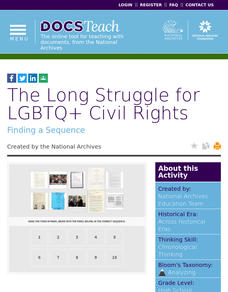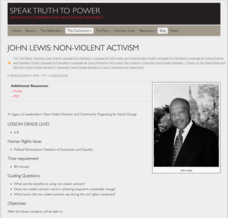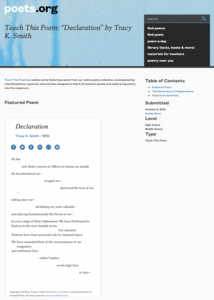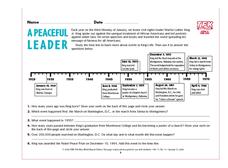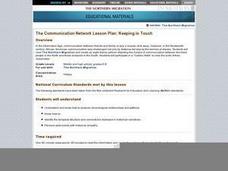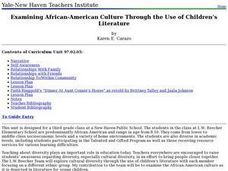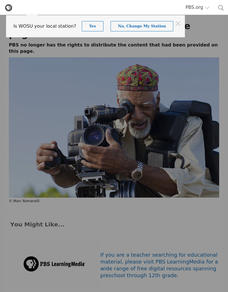K20 LEARN
Analyzing The "I Have A Dream" Speech
The famous words of Martin Luther King still resonate with scholars today. An enlightening lesson helps pupils examine the "I Have a Dream" speech in more depth and learn what impact it had on the civil rights movement. Young historians...
Newseum
Civil Rights: Turning Points
As part of a civil rights movement study, groups select an event from an interactive timeline that they feel marks a turning point in the struggle. After collecting evidence to support their choice, the teams develop a multimedia...
DocsTeach
The Long Struggle for LGBTQ+ Civil Rights
Academics analyze 10 primary documents and photos to create a timeline of the LQBTQ+ movement. The activity includes an online worksheet. Scholars also participate in a group discussion to understand the long struggle the LGBTQ+...
Speak Truth to Power
John Lewis: Non-Violent Activism
After comparing and contrasting non-violent and violent social movements, your young historians will take a closer look at the work and influence of John Lewis on the civil rights movement. They will then choose a current social justice...
National Park Service
Lesson 2: Hope
There's hope in music. Pupils discover what gave enslaved people hope by examining lyrics and music during their time of bondage. A series of prompts helps individuals investigate songs of enslaved people. The cumulative assignment...
Albert Shanker Institute
The March on Washington Logistics Then and Now
I have a dream ... that all pupils will be able to organize a march of their own after learning about how Bayard Rustin organized the 1963 March on Washington for civil rights. Young reformers work collaboratively examining informational...
C-SPAN
Presidential Candidate Firsts
Hilary Clinton may have been the first woman to run for president on a major party ticket, but she was only one example of an historic candidacy. Class members use video clips curated from C-SPAN to examine historical firsts in...
Academy of American Poets
Teach This Poem: “Declaration” by Tracy K. Smith
Tracy K. Smith's erasure poem "Declaration" challenges scholars to use their noticing skills to make connections between an engraving entitled "The Declaration of Independence" and Smith's poem. Class members record observations and...
C3 Teachers
Emancipation: Does It Matter Who Freed the Slaves?
Scholars generally agree on the emancipation of enslaved people in the United States. This inquiry-based lesson asks high schoolers to consider more than the claims of who freed the enslaved people but the significance of the issues...
Time For Kids
A Peaceful Leader
The legacy of Dr. Martin Luther King, Jr's life and message is just as important today as it was in his lifetime. Introduce elementary learners to the movement for civil rights with a timeline of Dr. King's life, as well as comprehension...
Facing History and Ourselves
Why Little Things Are Big
Often our decisions are impacted by a fear of how others see us. That's the big idea in a two-day lesson that asks how false assumptions, how our fear of how others may see us, impact how we act. After watching a video about such a...
PBS
Keep Your Head Up | Black America Since MLK: And Still I Rise
Change may be slow in coming, but things do change. Oprah Winfrey and Black Entertainment Television CEO, Robert L. Johnson, discuss the opportunities available to them due to the efforts of Dr. Martin Luther King, Jr. and other civil...
Curated OER
Remember the Bridge: Poems of a People
Fifth graders explore poems of African Americans. They research a famous African American, write a report, create a timeline of events in African American history, create a map of the New World, and research Molly Walsh. After...
Curated OER
Linking the Past with the Present
Fifth graders explore how Africans built South Carolina into an economic giant. They write an expository paper explaining how Africans and their descendants built the rice empire along the Carolina coastline. They write a persuasive...
Curated OER
Exploring Racism in America
Students examine racism, stereotypes, and biases in their personal lives and in the U.S. media. They discuss examples of racism, exploring the types of stereotypes and biases that still exist in our society. They access a multi-media...
Curated OER
The Communication Network: Keeping in Touch
Students read The Northern Migration and create an eight-frame cartoon depicting the means of communication between the freed people in the North and those enslaved in the South. The cartoons are displayed in a Gallery Walk.
Curated OER
The Family That Endured An Historical View of African-American Families As Seen Through American Literature and Art
Students identify racial stereotypes in advertisements from the past and survey their sources and implications. They compare advertisements from the past with those of today using similar approaches and create an original advertisement...
Curated OER
Folktales (African American, Chinese, Japanese and Korean)
Students participate in a variety of activities that are concerned with comparing different cultures through the literary genre of folktales. The stories are used to stimulate student interest and provide a context for how a society...
Curated OER
Children's Literature and African American Culture
Third graders examine various stories and poems and identify characteristics that make each individual unique. After analyzing the readings, they create their own personality poems to accompany self-portrait drawings. The poems and...
Curated OER
Famous Firsts Word Search
In this Black history month worksheet, students read the names associated with Black history month. Students locate the 10 words in the word search puzzle.
Curated OER
Life on Two Colonial Plantations in South Carolina
Fourth graders compare two colonial plantations. In this South Carolina history lesson, 4th graders compare the Drayton Hill plantation of Charleston Co. to the Walnut Grove Plantation of Spartanburg Co. This lesson plan uses primary and...
Curated OER
Exploring the Roots of Modern Dance in America
Students develop an understanding of how African culture impacted modern dance in the United States.
Curated OER
A Nation of Nations Lesson Plan: Charting African Ethnicities in America
High schoolers read a portion of the narrative, The Transatlantic Slave Trade, to explain the ethnic origins of enslaved Africans brought to the US. They create charts and bar graphs comparing ethnicities in the lowlands and tidewater...
Curated OER
Slave Resistance
Students examine slavery and slave resistance. In this history instructional activity, students read several excerpts on slavery then work in small groups to reflect and answer questions on the readings.




